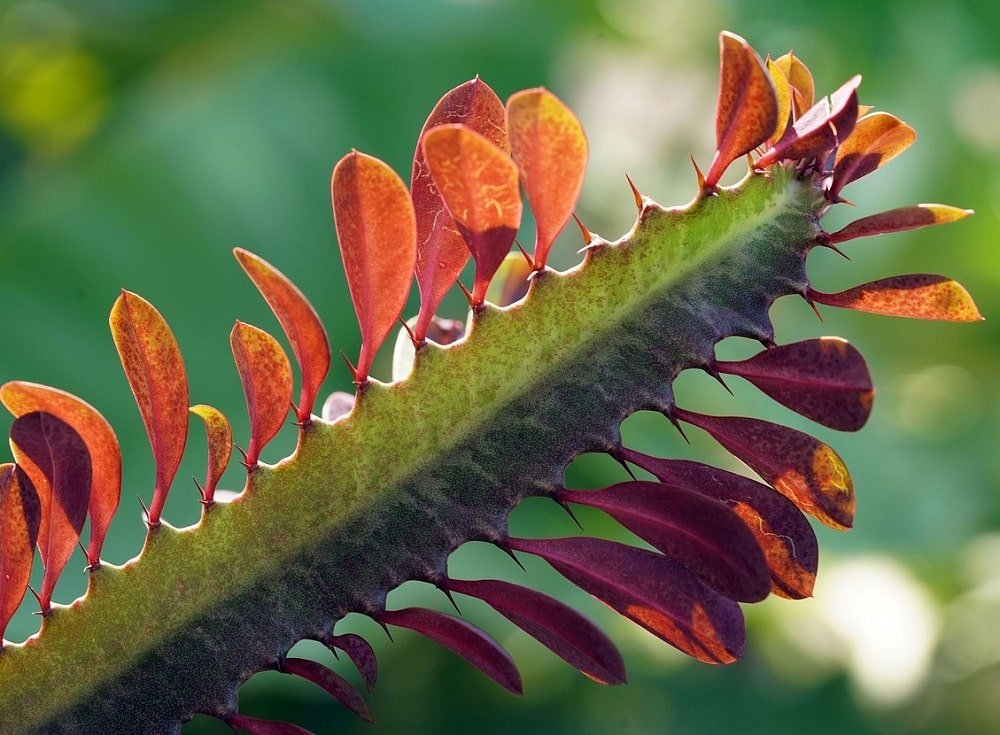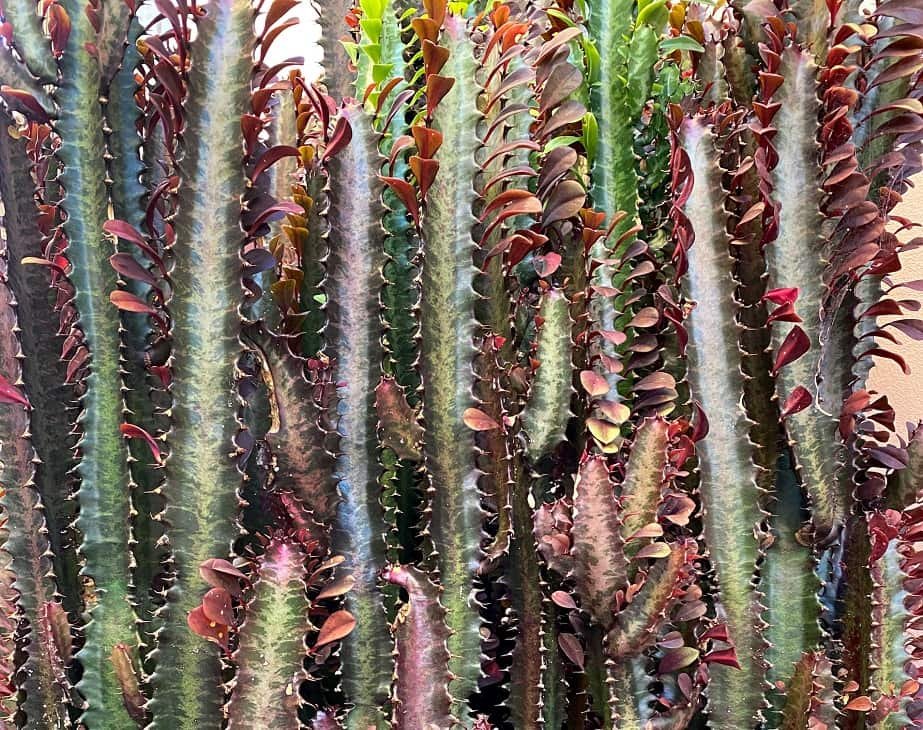African Milk Tree (Euphorbia trigona) Care & Propagation
Last Updated on 1st April 2024 by admin
Are you looking for a special and unique plant that will increase the attractiveness of your indoor garden? Consider the Euphorbia trigona, often known as the African Milk Tree. This interesting succulent, which is a native of Southern Africa’s dry regions, has grown significantly in favour among plant lovers thanks to its eye-catching look, minimal maintenance needs, and a number of advantages it provides.
In this article, we will go further into the intriguing world of the African Milk Tree, examining its features, growing techniques, uses, care, propagation and common issues. Take a journey on an eco-tour with us as we uncover the wonder of the African Milk Tree.

Table of Contents
The Complete Guide to African Milk Tree (Euphorbia trigona)
The African Milk Tree (Euphorbia trigona), also known as the African Tree Cactus or the Cathedral Cactus, is a succulent plant that belongs to the Euphorbiaceae family. The fact that it is not a true cactus should be noted despite the fact that it resembles one. The incredible heights of this plant, which may reach up to six feet, are due to its upright growth and unique branching pattern. Its stems are thick, three-sided, and showcase a geometric pattern, giving it a visually striking appearance. The African Milk Tree’s edges are lined with sharp spines, so caution should be exercised when handling it. During the growing season, the plant may develop small leaves, although they are usually short-lived and tend to fall off quickly.
The African Milk Tree’s unique and captivating appearance adds character to any space. Its unique triangular segments on its green stems form an interesting geometric design. The plant’s upright growth habit and these stems combine to create it a stunning focal point for any indoor garden. However, because to the sharp spines surrounding its edges, it is important to handle the African Milk Tree with care.
African Milk Tree Care or Natural Habitat
The African Milk Tree (Euphorbia trigona) is a remarkable succulent that originates from the arid regions of Southern Africa. Countries like Angola, Mozambique, and South Africa make up its natural habitat. The African Milk Tree has grown a tolerance for the severe conditions that are frequently present in desert habitats in these areas. The ability to successfully cultivate this unique plant depends on our ability to mimic its natural environment. Doing so will help us get significant insights into the conditions under which it prefers to grow.
An exciting task is to grow the African Milk Tree at home. This plant is recognised for its flexibility and hardiness, making it a great option for both beginner and a specialist gardener. Let’s explore the key factors to consider when cultivating and caring for this remarkable succulent.

1) Sunlight and Temperature Requirements
The African Milk Tree flourishes in bright sunlight and requires ample exposure to direct or indirect sunlight to thrive. In its natural habitat, the plant is often exposed to long hours of intense sunlight. The African Milk Tree needs at least six hours of sunlight every single day to develop well, which means location is important. Windows that face south or west are most effective in letting in the essential amounts of light.
In terms of temperature, the African Milk Tree prefers warm conditions. It can tolerate a wide range of temperatures, with optimal growth occurring between 65°F and 85°F (18°C to 29°C). These temperature ranges mimic the warm and arid conditions found in its native habitat. However, it’s important to protect the plant from frost and cold drafts, as it is sensitive to low temperatures.
2) Watering and Humidity
The African Milk Tree is highly suited to limited water resources because it has evolved to withstand drought conditions. It’s crucial to establish a watering schedule that matches these circumstances in order to replicate the plant’s natural environment. To avoid overwatering, which can cause root rot, let the soil dry out between waterings. Watering once every two weeks is usually sufficient during the plant’s active growth phase, which normally occurs in spring and summer. Reduce watering to once a month, though, during the winter dormant period. The plant can relax and conserve energy throughout this inactive period because it is in keeping with its natural rhythm.
The African Milk Tree grows in conditions with ordinary home humidity levels. It doesn’t require any additional precautions to grow in normal indoor humidity. It is an ideal choice for indoor growing because of its succulent nature, which enables it to adapt and withstand a broad variety of humidity conditions.
3) Soil and Fertilization
You need to plant your African Milk Tree in well-draining soil for optimal growth. Perlite or sand mixed with cactus potting soil works well since it enables extra water to drain, preventing soil from becoming wet. During the growth season, a balanced liquid fertiliser can be sprayed every four weeks and diluted to half strength. This offers the nutrients required for healthy growth. Avoid overfertilizing, as well, since this can cause salt to build up in the soil.

The African Milk Tree grows in desert environments with high temperatures and very little precipitation. This succulent has evolved a number of water conservation systems that enable it to endure in dry conditions. The plant can retain and use water well during dry periods thanks to the thick, succulent stems that act as water reservoirs. The soil can be sandy or rocky in its native environment, allowing extra water to readily drain away. This avoids wet conditions, which could negatively impact the roots of the plant. The roots have access to the essential moisture thanks to the well-draining soil, which also reduces the danger of rot brought on by stagnant water.
Understanding the African Milk Tree’s natural habitat might help one better understand the circumstances under which it prefers to develop. The plant’s resilience and adaptability are influenced by its capacity to flourish in dry environments, well-draining soil, strong direct sunlight, and high temperatures. The African Milk Tree can thrive in our indoor gardens when we are able to create a growing environment that closely matches these circumstances.
African Milk Tree Propagation
Propagation is a great way to grow your collection of succulents if you’re fascinated by the distinctive beauty of the African Milk Tree (Euphorbia trigona). You may enhance the amount of greens in your indoor garden or share the wonders of the African Milk Tree with others by growing new plants from existing ones through propagation. To help you successfully grow up and care for these wonderful succulents, we’ll go through the various propagation methods for the African Milk Tree in this guide.
1) Stem Cuttings
Stem cuttings are the most common and reliable method for propagating the African Milk Tree. Follow these steps to propagate your plant through stem cuttings:
- Select a healthy stem: Choose a stem that is mature, healthy, and free from any signs of damage or disease. A stem that is at least 6 inches long is ideal for successful propagation.
- Allow the cutting to dry: After selecting a stem, let it dry for a few days. This helps to prevent excess moisture and potential rot during the rooting process.
- Prepare a well-draining potting mix: Fill a small pot with a well-draining potting mix. A mixture of cactus potting soil and perlite or sand works well.
- Plant the cutting: Make a small hole in the soil and gently insert the dried stem cutting. Ensure that at least one-third of the cutting is buried in the soil to promote stability and root development.
- Provide optimal conditions: Place the potted cutting in a warm and bright location, avoiding direct sunlight. Maintain a temperature range between 65°F and 85°F (18°C to 29°C) to facilitate root growth.
- Water sparingly: During the rooting process, it’s crucial to water the cutting sparingly. Aim to keep the soil slightly moist, but not overly wet. Overwatering can lead to rotting of the cutting.
- Monitor root development: After a few weeks, roots should begin to develop. You can gently tug on the cutting to check for resistance, indicating root growth. Once a strong root system has formed, you can gradually adjust the watering routine to match that of a mature African Milk Tree.
- Transplanting: When the new plant has established a healthy root system and shows signs of active growth, you can transplant it into a larger pot using a well-draining soil mixture suitable for succulents.
2) Leaf Propagation
While less common, leaf propagation is another technique that can be used for the African Milk Tree. However, it’s important to note that leaf propagation has a lower success rate compared to stem cuttings. If you decide to try leaf propagation, follow these steps:
- Select healthy leaves: Choose healthy, mature leaves from the African Milk Tree. Gently twist or cut the leaves close to the stem.
- Let the leaves dry: Allow the leaf cuttings to dry for a few days until the cut ends callous over. This helps to prevent rot and promotes successful rooting.
- Prepare a suitable substrate: Prepare a well-draining substrate, such as a mixture of cactus potting soil and perlite.
- Plant the leaves: Place the dried leaf cuttings on top of the substrate, ensuring that the cut ends are in contact with the soil.
- Provide optimal conditions: Place the pot in a warm and bright location, away from direct sunlight. Maintain a temperature range between 65°F and 85°F (18°C to 29°C) to facilitate rooting.
- Mist the leaves: Mist the leaf cuttings occasionally to provide some moisture. However, be careful not to overwater, as excessive moisture can lead to rotting.
- Patience and monitoring: Leaf propagation requires patience, as it can take several weeks or even months for roots to develop. Monitor the leaf cuttings regularly and adjust watering as needed.
- Transplanting: Once the new plants have established roots and started growing, they can be carefully transplanted into individual pots using well-draining soil.
African Milk Tree propagation is an excellent opportunity to increase your collection of attractive succulents and introduce others to their stunning beauty. The appropriate circumstances of warmth, light, and well-draining soil are critical for optimal propagation, whether you select stem cuttings or leaf propagation. You may enjoy the wonderful presence of the African Milk Tree in your indoor garden by taking proper care of it as well as remaining patient while new plants grow up.
Benefits and Uses of African Milk Trees

The African Milk Tree (Euphorbia trigona) is an attractive addition to any indoor garden because of its distinctive look, minimal care requirements, and variety of applications. The African Milk Tree is a very valuable resource, both in terms of its ability to filter the air and its cultural importance. In this guide, we’ll explore the various benefits and practical uses of this remarkable succulent.
1) Air Purification
The African Milk Tree’s capacity to purify the air is a notable benefit. It helps to enhance the quality of indoor air because, like other succulents, it produces oxygen while absorbing carbon dioxide. Additionally, it may successfully eliminate several toxins and pollutants, like formaldehyde and benzene, that are frequently present in indoor environments. You may improve the quality of the air you breathe while enjoying the beauty of these plants by bringing African Milk Trees into your living areas.
2) Aesthetic Appeal
African Milk Trees are well recognised for their imposing, architectural appearances. It lends a sense of elegance and sophistication to any area with its tall, erect stems and distinctive branching patterns. Its vibrant green colour and the contrasting thorns along the stems make it an eye-catching centrepiece for any indoor garden or home décor. The African Milk Tree will attract admiration whether it is positioned as a stand-alone plant or as a component of a succulent arrangement.
3) Low Maintenance Requirements
The African Milk Tree is a great alternative for gardeners looking for low-maintenance plants. This succulent has become famous for its durability to abuse and capacity to flourish under varied circumstances. Given that it has evolved to dry regions, it needs little irrigation. In addition, it is hardy and versatile due to its ability to survive a broad variety of temperatures. The African Milk Tree is a low-maintenance plant that is perfect for people who are busy or are new to gardening.
4) Medicinal and Folklore Uses
Beyond its aesthetic and environmental advantages, several areas place cultural and medical value on the African Milk Tree. Various problems are treated with certain plant components in traditional medical procedures. For example, it is thought that the latex sap, which the plant releases when it is damaged, has antibacterial and anti-inflammatory properties. It has been applied topically to treat burns, bug bites, and skin disorders. The use of plant materials for medical reasons should be done with caution and under the supervision of experienced professionals, it is essential to keep in mind.
5) Ornamental and Landscape Design
The African Milk Tree is a favourite in decorative and landscape design because of its distinctive form and toughness. These succulents may be cultivated outside in climate-appropriate areas, giving gardens and landscapes a unique and attractive touch. Their towering, columnar structure may be incorporated into landscapes with a desert theme or utilised as eye-catching focal pieces. The African Milk Tree is a popular addition to outdoor settings due to its propensity to flourish in dry environments and its beautiful beauty.
Beyond its attractive appeal, the African Milk Tree has a variety of advantages and uses. This exceptional succulent adds beauty, practicality, and cultural value to both indoor gardens and landscapes thanks to its ability to filter the air, low care requirements, and cultural significance. The African Milk Tree is a tribute to the wonders of nature, whether you value it for its pleasing appearance, air-purifying capabilities, or possible beneficial qualities.
African Milk Tree: Common Issues and Solutions
Although Euphorbia trigona, the African Milk Tree, is a tough and adaptable succulent, it may have a few common problems that might harm its health and attractiveness. You may give the appropriate care and take care of any difficulties as soon as they arise by being aware of these problems and their answers. We’ll look at some typical problems that African Milk Trees might experience and provide workable remedies to make your plant thrive.
1) Overwatering and Root Rot
Overwatering is one of the most common problems encountered when caring for African Milk Trees. This can lead to root rot, causing the plant’s roots to decay and negatively impacting its overall health. To avoid overwatering and root rot:
- Ensure the soil has excellent drainage: Use a well-draining potting mix specifically designed for succulents. It should allow excess water to drain freely, preventing water from pooling around the roots.
- Water sparingly: African Milk Trees have adapted to arid conditions and require infrequent watering. Allow the soil to dry out completely between waterings and water only when the top inch of soil feels dry to the touch.
- Adjust watering during winter: During the plant’s dormant period, which typically occurs in winter, reduce watering frequency. The plant requires less water during this time.
2) Sunburn
African Milk Trees thrive in bright sunlight but can suffer from sunburn if exposed to intense sunlight for extended periods. Sunburn appears as pale, discolored patches or brown spots on the plant’s stems. To prevent sunburn:
- Gradually introduce the plant to direct sunlight: If you are moving your African Milk Tree to a sunnier location, do so gradually. Start with a few hours of direct sunlight and gradually increase the exposure over several weeks.
- Provide filtered or indirect sunlight: If intense sunlight is unavoidable, provide some shade or use a sheer curtain to filter the light. This helps protect the plant from direct sun exposure.
3) Pests
While African Milk Trees are generally resistant to pests, they can occasionally attract common succulent pests such as mealybugs and spider mites. To prevent and address pest infestations:
- Regularly inspect the plant: Check your African Milk Tree regularly for any signs of pests. Look for small, cotton-like clusters (mealybugs) or fine webbing (spider mites) on the plant’s stems or leaves.
- Use natural pest control methods: If you notice pests, you can try wiping them off with a cotton swab dipped in rubbing alcohol or a mild insecticidal soap solution. Repeat the process if necessary, ensuring to cover both sides of the leaves and stems.
- Isolate infested plants: If the infestation is severe, isolate the affected plant to prevent the pests from spreading to other plants.
4) Leaf Drop
Leaf drop can occur due to various reasons, including overwatering, underwatering, or sudden environmental changes. To prevent excessive leaf drop:
- Maintain a consistent watering routine: Water the African Milk Tree appropriately, allowing the soil to dry out between waterings. Avoid drastic fluctuations in watering habits.
- Avoid temperature extremes: Protect the plant from sudden temperature changes, drafts, or extremely cold temperatures, as they can cause stress and leaf drop.
- Provide a stable environment: Keep the plant in a location with consistent light conditions, avoiding frequent moves or changes in exposure.
You can preserve the health and vitality of your African Milk Tree by being aware of common issues and their treatments. The general health of the plant will be improved by using proper watering techniques, offering the right lighting conditions, and taking care of any insect issues as soon as they occur. Your African Milk Tree may flourish and remain a gorgeous addition to your indoor garden or home décor with a little love and care.
The African Milk Tree is a unique plant that combines aesthetic appeal with low maintenance needs. You may appreciate this succulent’s beauty while developing a healthier environment by giving it the proper lighting, temperature, watering, and soil conditions. Why then wait? Start your environmentally friendly path by adding the African Milk Tree to your indoor garden today.
Also Read About: Types of Carnivorous Plants

